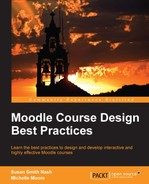Book Description
Learn the best practices to design and develop interactive and highly effective Moodle courses
In Detail
Moodle Course Design Best Practices is a practical guide that will teach you how to use the tools available in Moodle to develop unique courses for many kinds of organizations.
You will be able to utilize the themes that have been contributed by developers. You can incorporate many different types of course materials and interactive assessments. You will also learn how to modify the structure and presentation of resources, activities, and assessments to create courses for individual use, cohorts, and Massive Open Online Courses (MOOCs). The use of the various multimedia features to enhance your Moodle courses is also explained in this book.
What You Will Learn
- Set up a template for a series of courses
- Design the appearance of your course
- Manage the resources and activities of your course
- Organize your course content effectively
- Set up instructional materials for your course
- Select and set up assessments
- Include effective instructional strategies in your course
- Archive your course content for reuse
Downloading the example code for this book. You can download the example code files for all Packt books you have purchased from your account at http://www.PacktPub.com. If you purchased this book elsewhere, you can visit http://www.PacktPub.com/support and register to have the files e-mailed directly to you.
Table of Contents
- Moodle Course Design Best Practices
- Table of Contents
- Moodle Course Design Best Practices
- Credits
- About the Authors
- About the Reviewers
- www.PacktPub.com
- Preface
- 1. Preparing to Build an Exemplary Moodle Course
- 2. Planning Your Course
- 3. Organizing Your Course
- 4. Best Practices in Content Delivery
- 5. Designing Self-paced Independent Study Courses
- 6. Developing Cohort-based Courses with Teacher-student Interaction
- 7. Creating Student-centered Project-based Courses
- 8. Moodle for Online Communities
- Index
